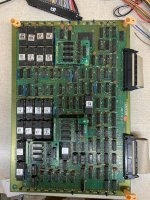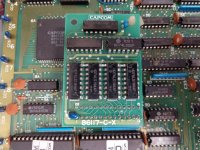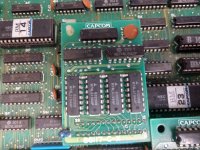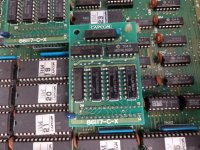So I picked up a mostly functional 1943 PCB that I want to fix. All the sprites in the game look like they've been chopped vertically and then each stripe offset of each other. For example the P-38 would be chopped into maybe 8 strips, with even numbered strips shifted up, and odd numbered strips shifted down. Same with the enemies, bullets, goodies etc etc. Some searches tells me that it might be a bad rom, but since I have not worked on this board before, I would like some guidance on where to start, before I remove ROMs from an old board.
Also, my particular PCB came with these daughter board looking PCB on the bottom board, it goes into vias that looks like should be a for bigger DIP chip. It looks as if Capcom didn't have enough logic chips, so they used a PCB with smaller logic chips to functionally create the chip they need. See pics. Anyone know why it was done this way and some history on it? None of the other 1943 boards I've seen have this.
Also, my particular PCB came with these daughter board looking PCB on the bottom board, it goes into vias that looks like should be a for bigger DIP chip. It looks as if Capcom didn't have enough logic chips, so they used a PCB with smaller logic chips to functionally create the chip they need. See pics. Anyone know why it was done this way and some history on it? None of the other 1943 boards I've seen have this.





